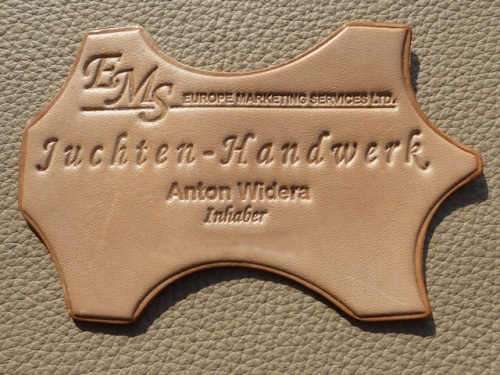Difference between revisions of "Russia leather"
| Line 5: | Line 5: | ||
| − | Russian leather is [[Vegetable-tanned leather|vegetable-tanned]] [[cow leather]] or [[Calfskin|calf leather]] with [[Measures and weights|thickness]] of about 1.6 - 3 mm. | + | Russian leather is [[Vegetable-tanned leather|vegetable-tanned]] [[cow leather]] or [[Calfskin|calf leather]] with a [[Measures and weights|thickness]] of about 1.6 - 3 mm. |
| − | Russian leather is mainly used for making [[leather shoes| | + | Russian leather is mainly used for making [[leather shoes|shoes]], [[leather bag|bags]] or [[Leather saddle|saddle goods]]. |
Originally, this type of leather was [[tanning leather|tanned]] with willow bark or birch bark and greased with birch tar oil for [[Waterproofing leather|waterproofing]]. The birch tea gives the leather its typical smoky [[Leather smell|smell]] (like smoked bacon). | Originally, this type of leather was [[tanning leather|tanned]] with willow bark or birch bark and greased with birch tar oil for [[Waterproofing leather|waterproofing]]. The birch tea gives the leather its typical smoky [[Leather smell|smell]] (like smoked bacon). | ||
| − | Usually [[vegetable-tanned leather]] is not particularly [[Waterproofing leather|waterproofed]]. But with birch tar oil, the water resistance can be achieved without [[Oils & fats in the leather industry| greasing the leather ]]excessively and without compromising the [[Breathability of leather]]. [[Leather shoes|Shoes]] and [[leather boots|boots]] from these leathers | + | Usually [[vegetable-tanned leather]] is not particularly [[Waterproofing leather|waterproofed]]. But with birch tar oil, the water resistance can be achieved without [[Oils & fats in the leather industry| greasing the leather ]]excessively and without compromising the [[Breathability of leather]]. [[Leather shoes|Shoes]] and [[leather boots|boots]] from these leathers keep the feet extremely warm, at very low temperatures, and cool at warm outside temperatures. |
Today, other [[vegetable-tanned leather]] is also called "Russian leather". For example, leather tanned with [[Mimosa|mimosa]], [[Tara|tara]] or chestnut. | Today, other [[vegetable-tanned leather]] is also called "Russian leather". For example, leather tanned with [[Mimosa|mimosa]], [[Tara|tara]] or chestnut. | ||
| Line 20: | Line 20: | ||
</p> | </p> | ||
<p align=center> | <p align=center> | ||
| − | ''In German-speaking countries, | + | ''In German-speaking countries, Russia leather is known as "Juchten Leder" or "Juften".''<br></p> |
<p> </p> | <p> </p> | ||
Revision as of 15:00, 23 March 2017
Russian leather is vegetable-tanned cow leather or calf leather with a thickness of about 1.6 - 3 mm.
Russian leather is mainly used for making shoes, bags or saddle goods.
Originally, this type of leather was tanned with willow bark or birch bark and greased with birch tar oil for waterproofing. The birch tea gives the leather its typical smoky smell (like smoked bacon).
Usually vegetable-tanned leather is not particularly waterproofed. But with birch tar oil, the water resistance can be achieved without greasing the leather excessively and without compromising the Breathability of leather. Shoes and boots from these leathers keep the feet extremely warm, at very low temperatures, and cool at warm outside temperatures.
Today, other vegetable-tanned leather is also called "Russian leather". For example, leather tanned with mimosa, tara or chestnut.
In German-speaking countries, Russia leather is known as "Juchten Leder" or "Juften".
Additional information









 a kotori web solution
a kotori web solution